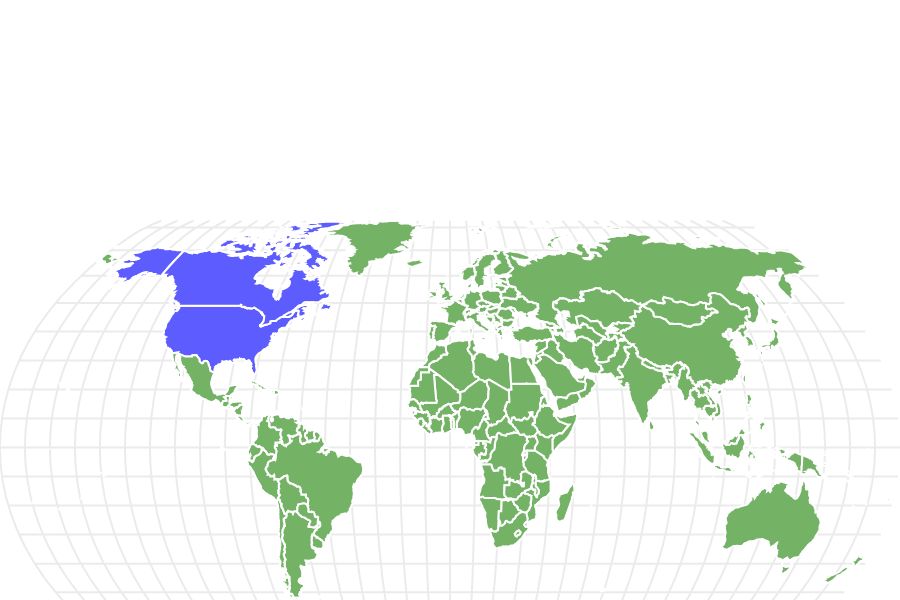Mackenzie Valley Wolf
Canis lupus occidentalis
Will travel up to 70 miles in a single day.
Advertisement
Mackenzie Valley Wolf Scientific Classification
- Kingdom
- Animalia
- Phylum
- Chordata
- Class
- Mammalia
- Order
- Carnivora
- Family
- Canidae
- Genus
- Canis
- Scientific Name
- Canis lupus occidentalis
Read our Complete Guide to Classification of Animals.
Mackenzie Valley Wolf Conservation Status
Mackenzie Valley Wolf Facts
- Prey
- Rodents, moose, bison, elk, caribou, sheep, mountain goats, deer, beavers, salmon, rabbits, squirrels, vole, and lemmings.
- Name Of Young
- pup
- Group Behavior
- Pack
- Fun Fact
- Will travel up to 70 miles in a single day.
- Estimated Population Size
- 40,000+
- Biggest Threat
- Grizzly bears, polar bears, tigers, scavengers, and humans.
- Most Distinctive Feature
- gray coat
- Other Name(s)
- Northwestern wolf, Mackenzie Valley wolf, Rocky Mountain wolf, Alaskan timber wolf, or Canadian timber wolf.
- Gestation Period
- Approximately 63 days
- Litter Size
- 4-6 pups
- Habitat
- Mountains, forests.
- Predators
- Grizzly bears, polar bears, tigers, scavengers, and humans.
- Diet
- Carnivore
- Type
- Mammal
- Common Name
- Northwestern wolf
- Number Of Species
- 1
- Location
- Western North America
Mackenzie Valley Wolf Physical Characteristics
- Color
- Grey
- White
- Skin Type
- Fur
- Top Speed
- 40 mph
- Lifespan
- 6-8 years, though some can live up to 17 years in captivity
- Weight
- 85-153 lbs
- Height
- 32-40 inches tall
- Age of Sexual Maturity
- 2 years for females, 3 years for males.
- Age of Weaning
- 8 weeks
View all of the Mackenzie Valley Wolf images!
The Mackenzie wolf goes by many names, but their inherited genetics from the wolves before them make them one of the top hunters in the entire world.
Their gray and white coat keeps them warm and hidden from anything they hunt, while their strong neck and jaw can take even the largest game (like bison and ox) down quickly. The desire to keep this top spot as a hunter is buried within their instinct since only the strongest pair is chosen as the alpha to reproduce.
In spite of the wolves ‘ superior hunting techniques, they may still be attacked by bears and other wolves during their hunts.
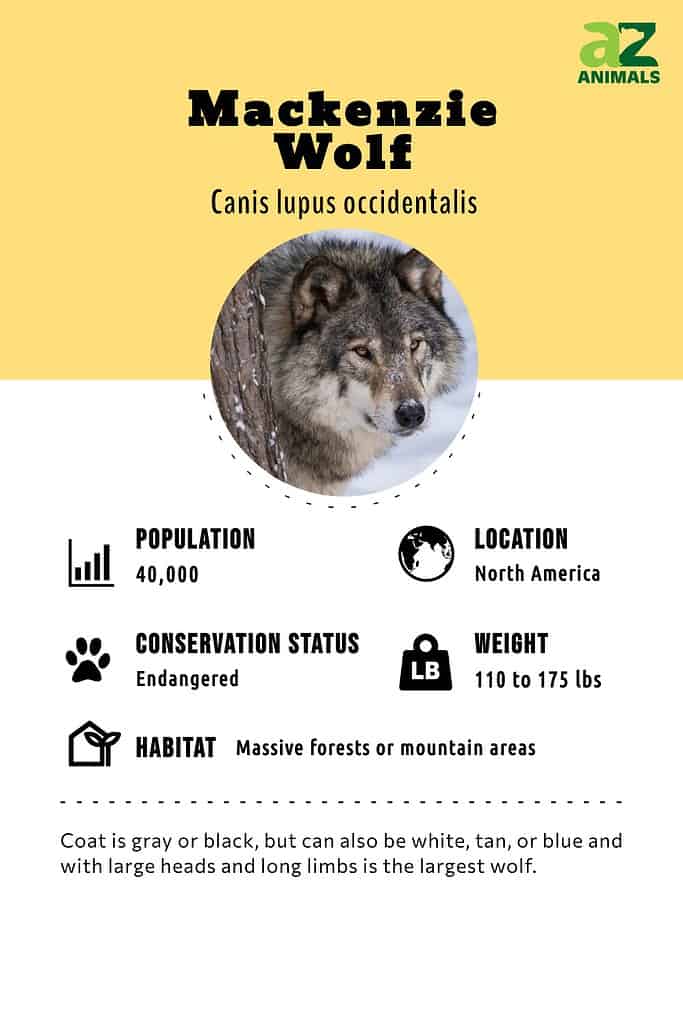
4 Incredible Mackenzie Valley Wolf Facts!
Though there are approximately 40,000 Mackenzie Valley wolves around today, they are quite an interesting breed. Here are a few facts about the apex predator that roams the northwest region of the Americas.
- The Mackenzie Valley wolf goes by many names, including the Alaskan timber wolf, Canadian timber wolf, Northwestern wolf, and the Rocky Mountain wolf.
- Though this wolf typically is gray or black, their coat can also be white, tan, or blue.
- The Mackenzie Valley wolf has a frame that makes it one of the best wolves in the world at hunting.
- Only the alpha pair in a pack reproduce.
Scientific Name

Mackenzie Valley Wolf is part of the Canidae family and its subspecies is Canis lupus occientalis.
©iStock.com/GlobalP
The Mackenzie Valley wolf is most commonly called the Northwestern wolf, but they have many other names that they go by as well, like the Alaskan timber wolf, the Canadian timber wolf, and the Rocky Mountain wolf. They are part of the Canidae family in the Mammalia class. Though they do not have any subspecies of their own, their subspecies is the Canis lupus occidentalis, which is also their scientific name.
While “Canis lupis” is simply the scientific name for the wolf species as a whole, they are differentiated with “occidentalis.” This name was given to the species by Sir John Richardson in the early 1800s. The Scottish naturalist noted that, while it would be easy to label the species by their distinct color, “occidentalis” was used to refer to the location where the wolf is found in. The word literally translates to meaning “of the western regions,” referring to their native North American habitat.
Evolution And Origin
The Mackenzie Valley wolf is a subspecies of the Gray wolf and is also considered one of the rarest wolves in the world. The forefather of the Gray wolf was Canis lepophagus, who lived in North America during the early Pliocene era, 2.5 to 5.3 million years ago. It is believed that this early Canis was the ancestor of both the wolf and the coyote.
Appearance
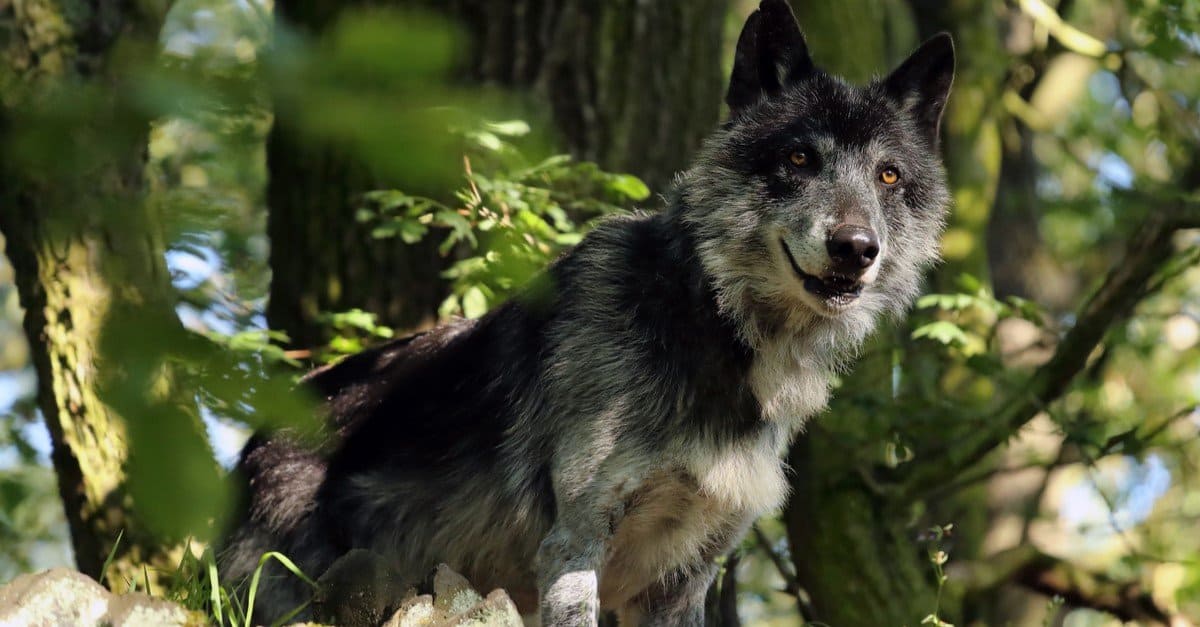
The Mackenzie Wolf (Canis lupus occidentalis) has a thick coat which helps them survive the brisk winters of the Northwest.
©Karel Bartik/Shutterstock.com
The appearance of the Mackenzie wolf is rather distinct. After all, the genetics of the wolf is the influence behind many domestic dog species. This particular wolf species has a bristly but thick coat, helping them to survive during the brisk winters of the Northwest region of the United States and Canada.
While their coat is sometimes white, the most common colors are gray and black. They are also found in tan and blue, depending on the region that they need to remain hidden in. Their multicolored appearance helps them to hide amongst forest areas as they hunt in their groups, which are also known as packs.
These wolves – also known as the Canadian timber wolf or the Alaskan timber wolf – have an incredibly strong and powerful neck to support their head. The head tends to be rather heavy and powerful, filled with sharp teeth that can overpower any of their prey. In fact, the reason that this animal is so large is because of the plentiful prey available in their habitat.
Males are larger than females with a weight of up to 187 lbs. in some areas. Females, on the other hand, typically don’t weigh more than 132 lbs.
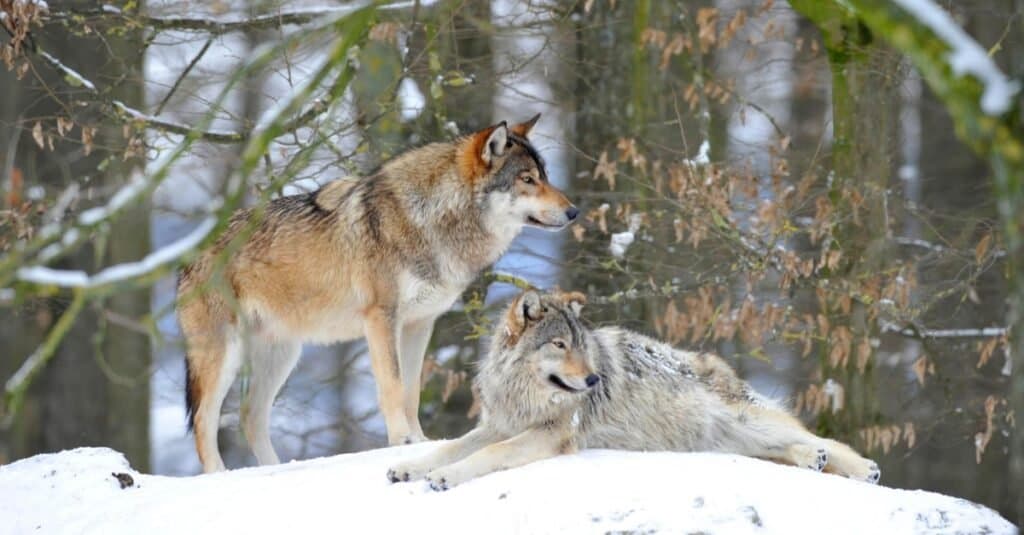
©imageBROKER.com/Shutterstock.com
Behavior
Mackenzie Valley wolves prefer to live within a pack, which is a group that consists of anywhere from 6 to 12 wolves. Breeding is only done by the largest and strongest pair in the group. They don’t often come in contact with humans, but their body language allows them to communicate with others in their pack.
The alpha wolves set the rules, and they are easy to identify by their tall stance. Wolves that are not alphas will exhibit submissive behaviors around these older pack members, lowering their bodies when they are around. They’ll also leave their tails down. This hierarchy is strongly enforced with the use of body language, posture, scent-marking, and vocalizations. While they are often depicted as howling at the moon, this caricature isn’t quite the reality. They will howl when the full moon is out, giving a little light to their stoic figure.
These wolves don’t like to stay in one place for very long, though they will come back to their primary habitat. Throughout the day, they will scan about 40 miles of ground hunting, which can take about 8-10 hours daily.
Habitat
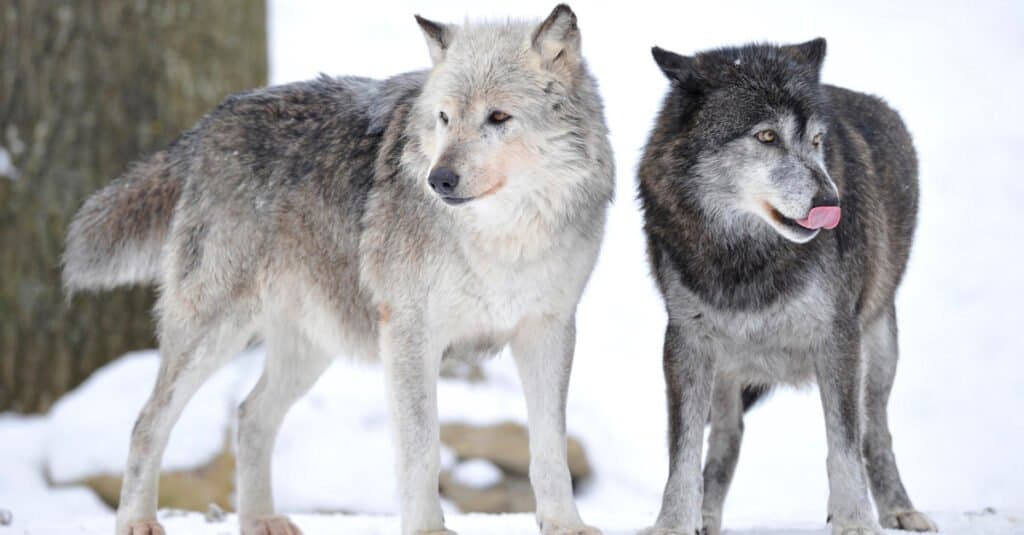
The Mackenzie Wolf can be territorial once they have established their home.
©imageBROKER.com/Shutterstock.com
Just like the common name of the Mackenzie Wolf (i.e., the northwestern wolf) suggests, the main home of this animal is the northwest area of North America. They can be found as high as Alaska, though they are also found in British Columbia, Alberta, and Saskatchewan. Sometimes, the breed also goes as far south as the northwest region of the United States.
Once the Mackenzie wolf establishes the home that they have chosen, it can be territorial of the area. They typically inhabit areas with massive forests or mountain areas. They flourish in the cold, which is what their coat is made to withstand.
Predators And Threats
Many of the habits of wolves focus on hunting at night for their prey. They are carnivorous, seeking out other animals as their source of nutrients. About 10 hours a day are spent looking for prey that can feed the wolf and their pack. They are apex predators, but they still have a few predators that will come after them (like humans and bears).
What Eats And Hunts Mackenzie Wolves?
Even as an apex predator, the Mackenzie wolf is not entirely safe. Apart from being hunted by humans, combat between this mammal and bison or bears can lead to their death. For the most part, the wolves can roam without the threat of other animals unless they directly attack them.
What Does The Mackenzie Wolf Eat?
The physique of the Mackenzie Valley wolf (or the Rocky Mountain wolf) makes them one of the top hunters in the world, which is why they have so many options to prey on. Due to their habitat in forests and mountains, the most common diet includes mountain goats, Dall sheep, lemmings, salmon, elk, musk oxen, snowshoe hare, wood bison, caribou, and even Sitka black-tailed deer. Sometimes, they’ll feed on beavers too.
The powerful teeth and strong muscles of the Mackenzie Valley Wolf (a.k.a. the Rocky Mountain wolf) are enough to take any of these animals down.
Reproduction And Life Cycle
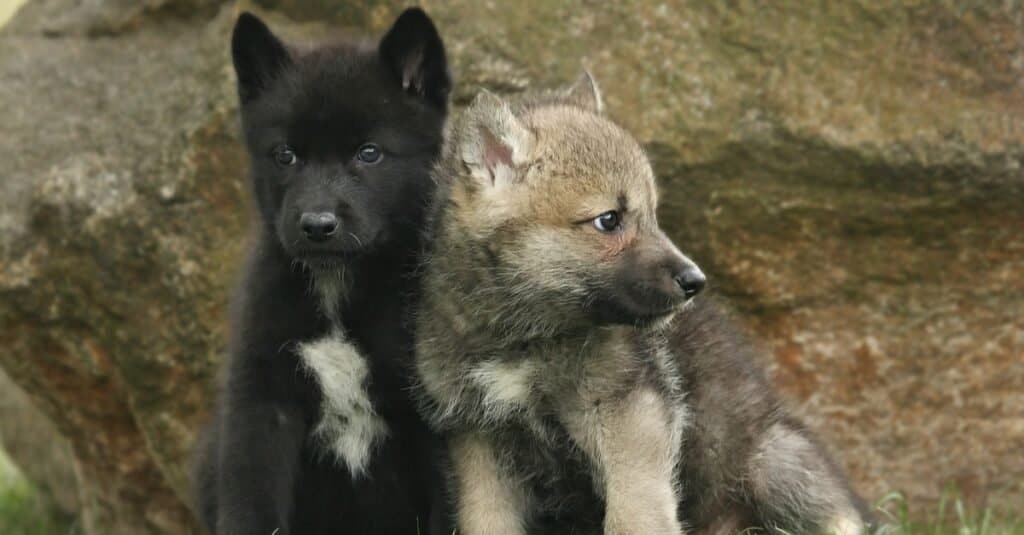
Two gray Mackenzie wolf puppies (Canis lupus occidentalis) will need their mother’s milk until 8 weeks of age.
©Jan Hejda/Shutterstock.com
While much of the species thrives on the ability to procreate, the Mackenzie Valley Wolf is a monogamous species. However, their breeding habits are rather unique because the pack only has one breeding pair. The pair is based on the oldest, strongest, and largest wolves in the pack, which may be a matter of genetically selecting the best chance of survival.
Most often, the mating season will occur in January and February, and the female will remain pregnant with her pups for about 63 days. Once the litter is born, she typically will give birth to 4-6 live young, which are also known as pups or whelps. These pups are protected within a den, protecting the defenseless pups while their hearing and sight develop (which can take up to 2 weeks). While the pups will explore beyond the den as early as 3 weeks old, they will need their mother’s milk until they are about 8 weeks old.
The pups will become adults between 6-8 months old. However, their body is not ready to reproduce until they are almost two years old as females. Males take approximately one more year before they are ready to reproduce. The average lifespan of these wolves is typically 6-8 years in the wild. However, animals in captivity may live twice as long for their protection from predators and consistent habitat.
Population
The main threats to the Mackenzie Valley wolf aren’t other predators, though there are a few larger animals that may hunt them. The loss of their habitat is the biggest cause of their depleting numbers. Humans will also hunt and trap these wolves, which is why less than 50,000 exist in Canada today.
An official population number is not currently provided by the IUCN Red List, but these wolves are endangered. The population’s attacks on local deer and elk help to naturally control these species, which benefits the overall ecological balance.
View all 164 animals that start with MMackenzie Valley Wolf FAQs (Frequently Asked Questions)
What is the Mackenzie wolf?
Sometimes referred to as the Northwestern Wolf, this animal primarily lives in North America, residing from Alaska to the northwestern region of the United States. They are one of the largest subspecies in the wolf family, and they can weigh up to 153 lbs. They typically have a lifespan of up to 8 years, though it is much higher in captivity.
Is the Mackenzie Valley Wolf extinct?
No. However, this wolf is currently endangered, and there are no efforts currently being made to protect them within their natural habitat. In Yellowstone, some northwestern wolves have been relocated, but they are largely left unprotected.
How big is the Mackenzie Valley Wolf?
The weight of the Mackenzie Valley wolf ranges significantly from about 101 lbs. for females to 137 lbs. for males. The general weight of this species varies, based on the location and diet of the particular pack.
How fast is a Mackenzie Valley Wolf?
The Mackenzie Valley can run at a speed of 40 mph.
Thank you for reading! Have some feedback for us? Contact the AZ Animals editorial team.
Sources
- The Western Wolves, Available here: https://people.wou.edu/~msabbe/cs195/wolf/wolf.html
- Wikipedia, Available here: https://en.wikipedia.org/wiki/Northwestern_wolf
- Animalia, Available here: https://animalia.bio/northwestern-wolf
- The National Wildlife Federation, Available here: https://www.nwf.org/Educational-Resources/Wildlife-Guide/Mammals/Gray-Wolf
- Wolves of the World, Available here: http://www.cosmosmith.com/mackenzie_valley_wolves.asp

